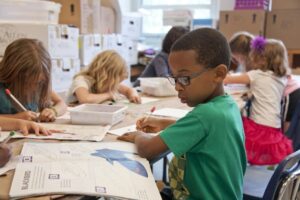“There is power in student voice, and it isn’t a voice any teacher can give. We don’t give voices. We make space for them in our curricula and classrooms, or we don’t. Especially in times like these when our nation is burning, we should listen to the young people. We should center their voices through choice of their tasks, choice of what they want to study, and overall handing them some leadership opportunities. How else will they practice taking over the world?”
Category: Restorative Practice & Absenteeism
Sep 03
By establishing routines that address the challenges of online learning, teachers can help students in grades 3 to 8 feel a sense of belonging.
“how can we create a positive classroom culture when we can’t even see our students face-to-face?It’s going to take a mixture of adapting the old tried-and-true beginning-of-the-year traditions to digital media and creating whole new practices and activities.”
Sep 02
Use Live Class Time to Center Relationships: By delivering content to students working at home, teachers can save live classes for what’s most important—the personal interactions that solidify learning.
“What made going to school meaningful?For both of us, that answer is simple: It was the human connections we made.”
Aug 28
During the COVID-19 crisis, restorative practices can help
While the coronavirus is a medical issue, a large part of what we are experiencing is a social crisis. Therefore, the relevance of consciously being relational becomes even more important. As many restorative practitioners understand, restorative thinking and practice isn’t just reserved for the workplace. “
Aug 17
To overcome the stress of this pandemic, educators must lead with relationships, routines and resilience by Katie Brackenridge
” The real question is whether we can afford not to invest in practices that support students’ social, emotional AND cognitive development right now. If we really care about student success, then we need to honor the biology of our brains — our interconnected centers of emotions, focus and learning.”
Jul 13
‘The Human Connection Is Everything’: Dave Eggers on What He’s Learned From Tutoring Students
“The human connection is everything. This distance learning moment during the pandemic has really proved that technology only gets you so far.”
Jul 11
Here’s a word to drop from your teacher vocabulary in order to build connections with kids
Drop the word EASY and build better connections with kids. Mistakes can be useful and productive for learning.
Jul 02
WhatsApp justice for teenage victim of homophobic gang attack
“A teenage boy who was attacked by a gang of youths in a Brighton park is the first to receive an apology via WhatsApp video as part of Sussex Police’s restorative justice project. The scheme, dubbed Restore DiverCity, gets offenders to speak directly to their victims so they can appreciate the impact of their actions …
Jun 29
How schools are using restorative justice to remedy racial disparities in discipline
“Fania E. Davis is a long-time social justice activist, civil rights trial attorney, restorative justice practitioner, and writer and scholar with a PhD in indigenous knowledge. In “The Little Book of Race and Restorative Justice,” Davis examines the still-pervasive, centuries-long cycles of racial prejudice and trauma in America and their repercussions, ranging from educational inequities …











